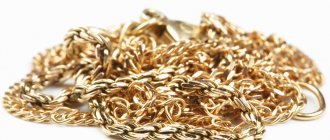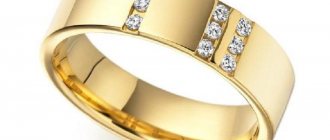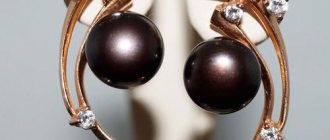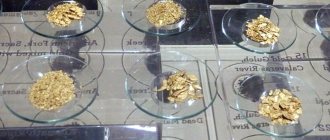Jewelry alloy is a combination of several inexpensive metals (compared to noble ones), which is used to make jewelry. To create an alloy, metals with different properties and characteristics are used. This allows you to obtain high-quality compounds that are resistant to external irritants.
Jewelry alloy decoration
Description of the alloy
Gold jewelry alloys are quite popular , but many people do not know what they are and what elements they contain . Their main component is gold (75–98%). The following additional components can be used: silver, copper, palladium, platinum. By adding additional metals, you can make an alloy with any shade - from red to light yellow, greenish.
Jewelry alloys are used to make expensive jewelry:
- rings;
- necklace;
- earring;
- tiara;
- tie clips;
- cufflinks
Ferrous metals, iron-carbon alloys with additions of chromium and nickel, are not considered jewelry, but they are used to make cheap products that imitate white gold and platinum. Stainless and surgical steel began to be used for the manufacture of various accessories with the advent of Art Nouveau, grunge, and punk styles. The alloy does not darken from moisture and does not cause allergies.
History of discovery
There is no exact information about when the first jewelry alloys appeared, but it is believed that even before our era, monarchs, rulers, and military leaders decorated their homes with various metal products, which were inlaid with precious and semiprecious stones.
The concept of “jewelry alloy” appeared in the 19th–20th centuries, when similar materials were separated into a separate group. From that moment on, jewelry began to actively spread throughout the world.
Golden Lion (Photo: pixabay.com)
Appearance
The popularity of jewelry alloys is explained by their attractive appearance and low price. They are used in the manufacture of jewelry, coating large products that are used as decoration.
Any experienced jeweler can determine by the type of jewelry what metals they are made of and what predominates in the combination. Example:
- A dull matte shade indicates tin content. The products weigh little, but due to their fragility they can become unusable under any mechanical influence.
- Green, yellow and gray shades indicate brass content. Such decorations are quite rare.
- A reddish tint indicates the presence of copper. With active wear, the color of the product may change.
- A silver or metallic tint indicates the presence of steel.
A dark shade indicates nickel content. This is a rather harmful additive because it causes allergic reactions in people with sensitive skin. The rarest jewelry alloys contain titanium.
Core Technologies
Jewelry production technology is divided into serial and individual methods. It consists of several main processes:
- Melting, casting and rolling.
- Rolling and drawing.
- Cold stamping.
To obtain a precious metal of the required standard, it is fused with alloying components. Melting is the transformation of a solid material into a liquid state or melt. In this state, metals are poured into special containers to give them the desired shape. This process is called casting.
Rolling of the resulting ingots is carried out to obtain metal wire and sheets with the required cross-section and thickness. Rolling produces profiles of various shapes - oval, round or square. Wire drawing is done using diamond dies. After this, it is used in filigree objects.
Stamping is the processing of metal surfaces using pressure. For this process, special devices called stamps are used. One type of cold stamping is embossing, which can be mass-produced or hand-made.
To protect objects from corrosion, galvanic coating and oxidation are used. The electroplating method involves gilding or silvering the surface, and the thickness of the layer depends on the type of decoration. The finished product is oxidized with sulfuric acid, after which a colorless varnish is applied.
If the jewelry is complemented with precious or semi-precious stones, then the ability to secure the stone plays a special role. The beauty and play of light in the stone, as well as the cost of the item, depend on the talent of the master and the method he chooses. Jewelry manufacturing technology includes the main fastening methods:
- The prong method is fastening using prongs that act as clamps. The stones are set into both castes and metal.
- The core method is intended for casteless fastening of one or more stones. A hole is drilled in the product, and stones are placed in them using metal particles or punches. The edges are treated with a grisant finish and have a fine notch.
- Blind crimping is characterized by crimpless fastening into castes and looks like a metal edging that crimps the stone around its entire circumference.
In the case of using stones that do not have precious status, as well as glass and marcasite products, an adhesive base can be used to attach them. Pearls and corals with incomplete holes are secured using glue.
Classification by technology and purpose
Jewelry products are usually classified according to their functional purpose and execution technique. Their cost largely depends on the latter. The main classes include various decorations, writing and toiletries, dishes, furniture, interior decoration items and souvenirs.
According to technical design, they are divided into three types: individual, machine and combined production. Doing it manually takes a lot of effort and time, and each product is unique, which is why the cost of such work is the highest.
Production using special equipment consists of performing basic processes and operations. Nevertheless, at the final stages it is impossible to do without human participation. Combined production looks similar. The most difficult and painstaking part of the work is performed by people, bringing machine-made parts to perfection.
Tools and equipment
A modern jeweler needs not only skills and knowledge, but also equipment for making jewelry, which includes the following items:
- Carpentry equipment (fixing vices, sets of files and needle files, cutters, drills, pliers, scissors, tweezers, wire cutters).
- Grinding equipment (a set of thread, metal and bristle brushes, polishing and grinding machines, flannel and canvas wheels).
- Optical instruments (magnifying glasses, microscopes) are required when working with small objects, as well as when cutting stones.
- A set of chemical reagents (acids, alkalis, salts). They are used to dissolve and process metals.
- Table scales equipped with weights.
In addition to tools, the room and workplace of the master play an important role. The workshop must have several rooms with exhaust ventilation. One room is equipped as the main place for work, the second is used to carry out necessary operations related to the release of harmful substances. Casting mechanisms and smelting furnaces are also located there. Drum and centrifugal tumbling are used in the final processing of products.
For successful work, the master also needs stationery (a set of simple pencils with an eraser, whatman paper, watercolor paints and brushes), since jewelry creativity is not complete without first creating sketches of the future masterpiece.
Compound
Since alloys based on silver, gold and platinum are expensive, people often choose costume jewelry. More often, tin is used as a base, which is combined with other metals - antimony, copper, aluminum, etc.
Prohibited additives
In addition to nickel, which can cause allergic reactions on the skin, lead was previously actively added to jewelry alloys. This metal remains on the skin, which causes discomfort and redness. Lead has now been added to the list of prohibited additives for jewelry making.
Lead (Photo: pixabay.com)
Types of coatings
Various materials are used to coat jewelry alloys. Types of coatings:
- Gold plating. Increases the strength and resistance of the product to mechanical stress and the influence of environmental factors. In order for the jewelry to retain its properties longer, the layer of gilding must be large enough.
- Jewelry alloy with rhodium plating or palladium film. These metals give the product a silvery tint. Spraying cannot be called very durable or wear-resistant, but it does not darken even with prolonged use.
- Ruthenium coating. The film changes the appearance of the jewelry to silver. The product acquires a characteristic metallic tint.
- Silver plated. The main disadvantage is rapid darkening in the absence of appropriate care.
- Copper coating. It is most often used to process bracelets, rings, and pendants to make them look like antique gold or bronze.
Kinds
Types of jewelry alloys:
- Cupronickel. A compound of manganese, iron, copper and nickel. Outwardly, it can be confused with silver. Does not darken over time, has high strength, does not corrode, and is easy to clean.
- Alpaca. Consists of tin, zinc, nickel, copper. This alloy first appeared in Mexico. It acts as a substitute for silver, but compared to it, alpaca has a duller shade.
- Neusilberg. Properties and characteristics are similar to alpaca and cupronickel-based alloys. Consists of zinc, nickel, copper. Has high elasticity and strength. The product takes on a green or blue tint.
- Red brass. An alloy of copper and zinc. Externally it resembles gold. It has high resistance to rust formation and ductility. Products made from this material are often covered with gold and enamel.
- Brass. An alloy with high wear resistance and strength. The main component is copper, to which nickel, manganese, tin, and zinc are added. Externally, brass looks like gold. Does not cause allergies.
You can also add bronze to jewelry alloys, which is characterized by high strength and wear resistance.
Brass faucet (Photo: pixabay.com)
Jewelry Materials
Man has loved to decorate himself and his home since ancient times. In the Stone Age, materials such as stone, wood, bone, clay, and shells were used to make various jewelry. But even then, people collected and used natural semi-precious stones: rock crystal, carnelian, sapphires, rubies, etc.
Our ancestors became acquainted with metals several thousand years ago. Many metals occur in nature in the form of large nuggets. In some cases they are quite large. Thus, in North America in the last century, an amalgamation of copper nuggets was found, the weight of which exceeded 400 tons. Large nuggets of gold (they will be discussed below) and metals such as tin, lead and some others are also known.
All these metals were used to make jewelry. Unlike stones, metals are easily deformed and take any shape; Unlike clay, they are durable. And copper and gold are also beautifully colored.
In the Ancient world, copper and subsequently bronze, an alloy of copper and tin, were most widely used. This is evidenced by numerous jewelry found in excavations. In the most ancient burials, rings, pendants, and bracelets are made of copper. As technology develops, the methods of making jewelry also change. If the rings and bracelets in the earliest burials are made directly from nuggets and bear traces of gross plastic deformation, then later people learned to cast them. The oldest casting known to historians - a copper ax - dates back six thousand years.
Casting is one of the main technological methods for producing products of any shape and size. In addition, during the smelting process it is possible to obtain alloys, that is, metals of a certain composition. The period of human development, which is called the Copper Age, gave way to the Bronze Age.
Pure copper is a ductile, soft metal. It is well processed by cold plastic deformation. However, products made from pure copper are also easily deformed, covered with an oxide film and scratches, thereby losing their attractiveness as jewelry.
The alloy copper - tin (bronze) has a number of obvious advantages. It has higher hardness and strength, and is less oxidized. It polishes beautifully and the mirror polish lasts longer.
The chemical composition of bronzes is different. The oldest bronzes contained 1–1.5% tin. Bronze objects of later origin already contain from 4–5 to 15–16% tin. Due to its excellent casting properties, bronze is widely used as the most common alloy. Bronze objects are found in excavations everywhere: in Europe, Africa, Asia, America.
Depending on the purpose of the product and operating conditions, alloys of different compositions were used. Thus, bronze with 13–16% tin was used to make weapons. These alloys have high wear resistance. In addition, bronze has a beautiful color: with 8% tin it is reddish-yellow; from 10% - orange-yellow; with 14% tin - yellow. Therefore, it, and later brass - an alloy of copper and zinc - was used to imitate gold.
For approximately five thousand years, bronze has been used as the most convenient casting alloy for creating artistic products (statues, bas-reliefs, railings, column capitals, ornaments, chandeliers, etc.). Bronze has high fluidity, low shrinkage, has a low melting point, can withstand various types of processing (forging, embossing, cutting, engraving), and resists wear and abrasion well.
However, the beautiful natural color of bronze changes over time. The natural aggressive influence of the environment over the course of centuries creates a dense crust of chemical products on its surface, the so-called patina of different colors - from light blue and green to brown and even black. Most often, noble patina has malachite green and greenish blue shades. Patina is formed mainly by oxides (oxides) and carbon dioxide salts of metals included in bronze. In industrial cities, sulfur compounds give the patina a black color.
Among the most ancient monuments from Egypt, Mesopotamia and other countries of the Ancient East, stored in museums in European countries, there are many artistic cast objects made of bronze. Thus, in one of the Parisian museums a bronze female figure of a canephora (caryatid) is exhibited - a work created in Sumer 2 thousand years before the new era.
Artists of Mesopotamia already at the beginning of the 3rd millennium BC. e. made cast bronze figures of animals. In the state of Urartu (on the territory of the Armenian Highlands), during the same period, ancient craftsmen prepared artistic bronze castings using lost wax models. The ancient Greeks used forging, stamping, embossing, drawing, embossing, polishing, engraving, inlay, soldering, gilding, and silvering in the production of artistic bronze products. In the era of the highest flowering of Greek culture, in the middle of the 1st millennium BC. e., bronze statues were created, the beauty of which is still amazing. Since ancient times, bronze has been used to make money.
For more than two millennia (from the end of the 4th millennium BC to the beginning of the 1st millennium BC), bronze was the most important material for the manufacture of weapons, tools, artistic products, and jewelry. The Bronze Age made a significant contribution to the development of material culture.
Several thousand years ago, man became acquainted with gold. Obviously, this happened during the period when he discovered other native metals - copper, silver, tin. However, gold very quickly took a special place in people's lives.
The special properties of gold: attractive color, resistance to corrosion, the ability to maintain shine for a long time - immediately distinguished it from a number of metals known to man at that time. Gold was universally valued as a precious, noble metal. It has become a universal monetary equivalent and remains so to this day. In all countries of ancient civilization, gold accumulated in the treasuries of kings, pharaohs, emperors and rich nobles. Gradually it became a measure of wealth and power.
Initially, gold mining was limited to searching for more or less large nuggets. Subsequently, gold-containing sands began to be washed and grains of gold separated from the waste rock were smelted into ingots.
Egypt was considered the richest country. It is no coincidence that when excavating the burial places of the Egyptian nobility, archaeologists find a lot of jewelry and other gold objects. “Reflections of gold flashed everywhere, as soon as the first ray splashed... Gold on the floor, gold on the walls, gold there, in the most distant corner, where there is a coffin next to the wall, gold is bright and light, as if it had just come out completely new the hands of a goldsmith…” wrote one of the participants in the first penetration into the tomb of an unknown pharaoh, found in 1907 in the Valley of the Kings near Thebes, on the left bank of the Nile.
15 years later, the English archaeologist Howard Carter discovered the tomb of Pharaoh Tutankhamun, who ruled in the 14th century, in the same place. BC e. Priceless works of ancient art have been preserved here, many of which are made of pure gold. The mummy of the young pharaoh rested in a golden coffin that weighed 110 kilograms. The mask of Tutankhamun, made of gold and multi-colored ornamental stones, is extremely beautiful.
But only a small fraction of those truly incalculable riches with which the rulers of the Ancient World were surrounded during their lifetime ended up in the graves and crypts. So, according to legends, the queen of Assyria Semiramis, in order to gain the favor of the gods, cast their giant images from pure gold. One such statue, about 12 meters high, weighed 1,800 talents (about 30 tons). The statue of the goddess Rhea was even more grandiose: it took 8,000 talents of pure gold (almost 250 tons). The goddess sat on a throne, flanked by “guards”: two large golden lions.
About two and a half millennia ago, the first gold coins appeared. Their homeland was Lydia, a powerful slave state located in the western part of Asia Minor. Lydia carried on extensive trade with Greece and its eastern neighbors. For the convenience of settlements during trade transactions, the Lydians introduced into circulation a minted gold coin - a stater, on which a running fox was depicted - a symbol of the main Lydian god Bassareus.
After the conquest of Lydia by the Persian king Cyrus, coins began to be minted in other countries of the Near and Middle East. For example, dariks - coins of the king of Persia Darius I, on which he is depicted shooting from a bow - have become widespread.
The first Russian gold coins—kopecks and nickels—appeared at the beginning of the 17th century, issued into circulation by Vasily Shuisky.
Under Empress Elizabeth Petrovna, a large gold coin worth 10 rubles appeared, called “imperial” in honor of the ruler of Russia, who was clearly partial to gold: after her death, a substantial inheritance was left in the palace - many large and small chests filled with gold chervonets.
In nature, gold is found in a dispersed state in rocks - ores or placers in the form of inclusions of about 100 microns and smaller. There are nuggets weighing up to several kilograms.
The largest nuggets were found in Australia in the last century. In 1869, there was a meeting with a “welcome stranger” who weighed 71 kg. And three years later they discovered the “Holterman plate”, which, together with rock inclusions, weighed 225 kg, about 100 kg of which was gold. These unique gifts of nature were not preserved: both nuggets were melted into ingots. The largest gold nugget in Russia weighing 36 kg was found in 1842 in the Urals in the Miass River basin by artisan Nikifor Syutkin.
Native gold almost always contains silver (in a mass fraction from 5% to 30%) and almost always copper (in a mass fraction up to 20%), and occasionally platinum group metals.
Gold-containing minerals include: native gold, electrum, cuprous gold, gold tellurite - cornerite, calaverite, sylvinite, etc. There are primary deposits, where gold is found in the form of inclusions in ore bodies, and placers. The latter are formed as a result of the destruction of primary deposits, the removal of gold along with the rock by natural waters and its deposition in the valleys of rivers and streams.
Among the ancient peoples who inhabited Latin America, gold was considered a sacred metal, the metal of the Sun God. Their rulers and priests came up with many rituals that were supposed to testify to the unbreakable connection between the power of the mighty of this world and the wealth given to them by the gods in the form of gold. One of these rituals among the Aztecs was as follows. In the pre-dawn hour, the leader was covered with fragrant oil, and then, at the signal of the high priest, rubbed with gold powder. The gilded leader, surrounded by his retinue, sat on a reed raft and set sail across the surface of the lake towards the rising sun. When the red-hot disk rose from behind the mountains, the ceremonial bathing of the leader began, during which the priests showered him with rings, bracelets, pendants and other gold jewelry from golden goblets and bowls. After this procedure, no one should have any doubt that their ruler was the son of the Sun.
The documents preserved information about the masterpiece of centuries-old Inca culture - the city of Cusco, one of the richest cities in Peru. Its decoration was the gold-covered temple of the Sun. The walls and ceiling of the central hall of the temple were decorated with gold sheets, and on its eastern side a golden disk shone - the face of a god with eyes made of gems. When the first rays of the rising sun fell on this disk, the mysterious eyes of the god lit up with multi-colored lights. The ceiling of the temple was all strewn with openwork golden stars, dragonflies, butterflies, birds, which, as if weightless, hovered over the people and were so magnificent that their beauty aroused reverent admiration from everyone who got there. There was a golden garden adjacent to the temple. Trees, bushes, birds - everything was skillfully made of gold. In the garden there were golden thrones on which sat statues of the sons of the Sun - the Great Incas.
However, the holy city of Cusco was barbarically sacked and completely destroyed by the Spanish conquistadors led by Francisco Pizarro. The most valuable creations of the ancient Incas were melted into gold bars, convenient for transportation across the ocean.
The gold accumulated over many centuries by the Aztecs, Incas, Mayans and other peoples of the New World poured into Europe in a wide stream. For two centuries, flotillas of gold-laden galleons departed hourly from the shores of America, heading for the Trinidad Peninsula. But, as if taking revenge on the conquerors, the ocean more than once snatched the stolen gold from their hands and reliably hid it in its depths.
According to historians, the remains of approximately 100 galleons rest in the Caribbean Sea, for example. About the same number of ships sank off the southeastern tip of Florida. The Bahamas and Bermuda are a graveyard for more than 60 Spanish ships. About 70 lie on the bottom of the Gulf of Mexico. And all of them, without exaggeration, can be called gold. Thus, the galleon “Santa Rosa” carried away piles of gold and other treasures from the palace of the famous Montezuma to the seabed. In total, according to some foreign experts, the ocean “borrowed” several hundred billion dollars worth of gold, silver and other valuables from humanity.
Gold!.. No other metal has played such an ominous role in history. For the right to own it, bloody wars were fought, entire states and peoples were destroyed, and serious crimes were committed.
Thanks to the cunning shown by goldsmiths of the past, a small part of the unique heritage of world culture has survived to this day in its original form. Thus, near Bangkok, the capital of Thailand, there stood, unknown by whom and when, a huge statue of Buddha, made, as it seemed, of stone. Half a century ago, they decided to build a wood processing plant on that site, and therefore the statue had to be moved. When it was removed from the pedestal, despite the precautions taken, it was damaged, and in the depths of the resulting crack something sparkled. The work managers decided to remove the cladding from the statue. The Buddha, made of pure gold and weighing 5.5 tons, appeared before those present. Experts found that the monument dates back at least seven centuries. Now the statue is kept in the famous Temple of the Golden Buddha.
Gold is one of the heaviest metals. It was this property that allowed Archimedes to convict the jewelers of the Syracusan king Hieron of fraud, who made a gold crown to his order. The king asked the scientist to find out whether the crown was made of pure gold, or whether part of it was replaced with another metal. Archimedes weighed the crown and then immersed it in water and determined the volume of water displaced. Dividing the mass by this volume, he obtained the density of the material not 19.3 kg/cm3, but less. This meant that jewelers appropriated some of the gold, replacing it with a lighter metal.
Pure gold is a very soft and ductile metal. A piece of it the size of a match head can be stretched several kilometers long or rolled into a transparent bluish-green sheet with an area of 50 m2. If you scratch your fingernail on pure gold, it will leave a mark. Therefore, gold used for jewelry usually contains so-called alloys - additives of copper, silver, nickel, cadmium, palladium and other metals that give it strength and hardness.
However, one of the most important properties of gold is its exceptionally high chemical resistance. It is not affected by acids and alkalis. Only aqua regia (a mixture of concentrated nitric and hydrochloric acids) can dissolve gold. The famous Danish physicist Niels Bohr once took advantage of this circumstance. In 1943, fleeing the Nazi occupiers, he was forced to leave Copenhagen. But he kept two gold Nobel medals of his colleagues - German anti-fascist physicists James Frank and Max von Laue (Bohr’s own medal was taken from Denmark earlier). Not risking taking the medals with him, the scientist dissolved them in aqua regia and placed the unremarkable bottle further away on a shelf where many similar bottles and vials with various liquids were collecting dust. Returning to his laboratory after the war, Bohr found a precious bottle. At his request, the staff separated the gold from the solution and re-cast both medals.
Currently, a large share of the gold mined is used to make jewelry, ornaments, souvenirs and dentures.
“The second high metal is called silver,” wrote M.V. Lomonosov, “its color is so white that if the silver is completely pure and only washed after melting and not polished, then it appears from a distance as white as chalk.”
Many peoples associated silver with prosperity and joy. Thus, a silver spoon symbolized success. Jewelry with the image of the Moon - the moon - was considered sacred and, according to their owners, had magical powers. Most often they were made of silver. Lunar bowls decorated with grain, found by archaeologists in the Smolensk region at the end of the last century, were made by Russian craftsmen in the 10th century.
Grains are small silver or gold balls with a diameter of 0.5 to 4 mm. They lay out a flat or relief pattern, which is sometimes combined with filigree - a pattern made of thin wire.
Since ancient times, people have known about the magical cleansing power of silver. In Rus' there was a custom to “silver” a newborn: at baptism or when the baby was first bathed, an object or coin made of silver was dipped into the water. Newly dug wells were blessed with a silver coin. It has been scientifically proven that silver ions disinfect water.
It is known from history that in 327 BC. e. Alexander the Great invaded India, but an epidemic of gastrointestinal diseases broke out in his army. This forced the commander to abandon further military action. However, the epidemic did not affect the military leaders and Alexander himself, who used silver rather than tin utensils during the campaign.
Previously, wealthy people had such a thing as “family silver.” It was carefully looked after and used exclusively on special occasions. Thus, more than 3 thousand items made in the same style were included in Count Orlov’s service. The total weight of the silver dishes was about 2 tons. Moreover, the cost of the finished product was many times higher than the cost of the precious metal itself, since it was made by talented craftsmen and it was a valuable work of decorative and applied art.
Silver is well processed by cutting: engraved, chopped, sawed off. The ductility of pure silver is so high that from 1 g of metal it is possible to draw a wire about 2 km long using drawing. The finest silver wire - beat - is used for silver embroidery. The high ductility of silver allows it to be made into sheets a quarter of a micrometer thick. This property is used to produce silver leaf.
Silver has the highest reflectivity. Therefore, since ancient times, mirrors have been made of metal, including silver, polished to a shine. In modern mirrors, precious metal is applied to the glass on the back side in a very thin layer using a special technology.
In the X–XI centuries. The masters of Kievan Rus achieved great success in the artistic processing of silver, as the ancient author Theophilus wrote about in his treatise on jewelry making techniques. Old Russian masters skillfully used the technique of cloisonné enamel, filigree and graining, embossing and basma, and engraving. They created priceless items made of silver with an “allowance” of niello.
Since the 12th century. Moscow became the center for the production of silver products. In the workshops they made silver dishes: bratins, glasses, ladles, on which inscriptions, patterns, and ornaments were engraved. Plates, feet, charms, snuff boxes, and icon frames were decorated with black patterns. The art of silversmiths of the ancient city of Veliky Ustyug was especially famous.
Starting from the 1840s, the process of creating a national school was underway in Russian decorative and applied arts. Increasingly, the gaze of masters turned to the ornamental richness and multicoloredness of ancient Russian applied art, which led to the formation of the neo-Russian style.
In this regard, it is interesting to compare the experience of two Russian centers for the artistic processing of silver - St. Petersburg and Moscow. In St. Petersburg, they mainly adhered to the Western direction, since many European silversmiths and jewelers worked there. The St. Petersburg masters were highly qualified, but did not offer fundamentally new artistic and stylistic solutions. In Moscow, the national school of artistic silver received vivid expression, and, in addition, it contributed to the development of the system of its production. So, if in the 18th - first half of the 19th centuries. silversmithing in Russia was concentrated in the hands of individual jewelers or in small workshops working to order, then the second half of the 19th - beginning of the 20th century. — the time of the emergence of new technologies that made it possible to satisfy the growing demand of the Russian buyer for things created in the neo-Russian style.
All this contributed to the emergence and rapid development of domestic jewelry companies. As well as Russian artistic and industrial exhibitions, which were regularly held since 1829. Constant competition and a wide market stimulated the search for new technologies and techniques for working with silver, maintaining a high artistic level of products and cleanliness of finishing. Therefore, famous artists and sculptors were attracted to cooperate with jewelry companies, and professional training centers were organized at their enterprises. For example, in the Sazanov company (founded in 1793 by the merchant Pavel Fedorovich Sazanov, the owner of a workshop for the production of silver products) Bykovsky, Vitali, and Klodt worked. Academician Bortnikov worked at the Gubkin company (founded in 1841 by the merchant and manufacturer Ivan Semenovich Gubkin).
At the factory of gold and silver products of Pavel Akimovich Ovchinnikov, founded in 1853, one of the largest schools for training artists and silversmiths was organized. This made it possible to organize the production of relatively inexpensive and high-quality products accessible to wide sections of society.
The large number of Russian jewelry firms provided a variety of artistic decorations and silver processing technologies. Moreover, each of the companies had its own identity. Thus, Postnikov’s company specialized in products made using the filigree technique; Ovchinnikov's company - on products with enamel; Khlebnikov's company - on imitations of other materials in silver; Semenov's company - in the manufacture of items decorated with niello; Gubkin's company - on embossed silver; Faberge firm - on guilloché enamel.
In the second half of the 19th century. Small sculptures (sculptures of small forms) dedicated to hunting themes became very popular: scenes of Russian hound and falconry, the image of a bear - the symbolism of Russia. The peasant theme also became popular: images of plowmen, peasants at a festival, vacationers, etc. The folk theme was reflected in silverware. Ashtrays-bast shoes, salt shakers in the shape of birch bark tueskas, glass holders in the shape of village log huts, crackers, cups in the form of tubs, etc. became widespread. Of particular interest were items made of silver in combination with enamel.
By the beginning of the 20th century. Russian artistic culture was in search of a new aesthetics, strengthening the Art Nouveau style. The range of silver products generally retained the recognizable shapes and decor of items from the second half of the 19th century. A combination of semi-precious or ornamental stones with hot filigree enamels was used. A new technique for decorating silver at the beginning of the century. became the technique of stained glass (transparent) enamels, which gave the products sophistication.
Russian artistic silver, thanks to the activities of domestic jewelry firms, gained pan-European fame, and the school of Russian artistic silver became a phenomenon in European decorative and applied arts.
Thus, although silver was considered the second noble metal after gold, gold is inferior to it in terms of versatility and variety of applications.
Advantages and disadvantages
Pros:
- Low price compared to jewelry made from precious metals.
- Hypoallergenic. The products are suitable for people with sensitive skin.
- Big choice. You can find different types of jewelry in stores.
Minuses:
- Susceptibility to environmental factors. If you do not properly care for products made from such materials, they will quickly lose their original appearance.
- Not durable compared to jewelry made from precious metals.
- No indication of the exact composition of the alloy.
Features of care
Jewelry alloys have low resistance to environmental factors. If left untreated, they will quickly lose their attractiveness. Therefore, you need to study the rules for caring for such jewelry in advance.
Does the alloy darken?
To understand whether a jewelry alloy darkens or not, you need to study its composition and coating. Products coated with silver will darken even if proper care is followed.
Is jewelry alloy susceptible to corrosion?
Without an additional protective coating, some alloys may rust if exposed to moisture for a long time. If the metal on which the jewelry is made has high corrosion resistance, the risk that the surfaces will become covered with rust is minimal.
Cleaning methods
To clean jewelry, you can use napkins or soft cloths. The use of cleaning products and soap is not recommended.
Characteristics of precious metals
Gold:
- yellow color;
- high plasticity;
- melts at a temperature of 1063 degrees;
- boils at a temperature of 2530 degrees;
- does not oxidize in air or water;
- low strength and hardness.
Silver:
- White color;
- melts at a temperature of 960.5 degrees;
- boils at a temperature of 1955 degrees;
- has high thermal and electrical conductivity;
- with an increased content of hydrogen sulfide in the environment, it becomes covered with a dark coating of silver sulfide;
- high plasticity;
- low strength and hardness.
Platinum:
- color – silver-white;
- melts at a temperature of 1773 degrees;
- boils at a temperature of 4300 degrees;
- does not collapse under the influence of air and water;
- low thermal and electrical conductivity;
- high plasticity;
- low hardness.










